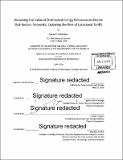| dc.contributor.advisor | Ignacio Pérez-Arriaga and Claudio Vergara. | en_US |
| dc.contributor.author | Huntington, Samuel C | en_US |
| dc.contributor.other | Technology and Policy Program. | en_US |
| dc.date.accessioned | 2016-10-14T15:54:33Z | |
| dc.date.available | 2016-10-14T15:54:33Z | |
| dc.date.copyright | 2016 | en_US |
| dc.date.issued | 2016 | en_US |
| dc.identifier.uri | http://hdl.handle.net/1721.1/104827 | |
| dc.description | Thesis: S.M. in Technology and Policy, Massachusetts Institute of Technology, School of Engineering, Institute for Data, Systems, and Society, Technology and Policy Program, 2016. | en_US |
| dc.description | Cataloged from PDF version of thesis. | en_US |
| dc.description | Includes bibliographical references (pages 50-54). | en_US |
| dc.description.abstract | The proliferation of distributed energy resources (DERs) in electric distribution networks brings both challenges and opportunities to the management of the electric grid. In the right locations these resources can provide value to the network by reducing congestion and losses and deferring investment in network upgrades. To unlock this value, however, more efficient economic signals need to be sent to the network users who ultimately make the decisions to install and operate these technologies. This thesis proposes a modeling framework for evaluating the impact of tariff structure on the adoption of DERs within distribution networks, and their ensuing impact on network cost drivers. The framework combines a dynamic end user model, which simulates the operational and investment decisions of electric customers, with a distribution-level power flow model that allows for precise observation and allocation of network costs. Case studies suggest that the types of technologies and their patterns of adoption within the network are likely to differ significantly depending on the pricing scheme. Prices that incorporate the cost of losses and congestion within the distribution network are shown to lead to DER adoption patterns that result in the greatest benefits to both customers and the network. I conclude with policy recommendations and directions for future research. | en_US |
| dc.description.statementofresponsibility | by Samuel C. Huntington. | en_US |
| dc.format.extent | 68 pages | en_US |
| dc.language.iso | eng | en_US |
| dc.publisher | Massachusetts Institute of Technology | en_US |
| dc.rights | M.I.T. theses are protected by copyright. They may be viewed from this source for any purpose, but reproduction or distribution in any format is prohibited without written permission. See provided URL for inquiries about permission. | en_US |
| dc.rights.uri | http://dspace.mit.edu/handle/1721.1/7582 | en_US |
| dc.subject | Institute for Data, Systems, and Society. | en_US |
| dc.subject | Engineering Systems Division. | en_US |
| dc.subject | Technology and Policy Program. | en_US |
| dc.title | Unlocking the value of distributed energy resources in electric distribution networks : exploring the role of locational tariffs | en_US |
| dc.title.alternative | Unlocking the value of DER in electric distribution networks : exploring the role of locational tariffs | en_US |
| dc.type | Thesis | en_US |
| dc.description.degree | S.M. in Technology and Policy | en_US |
| dc.contributor.department | Massachusetts Institute of Technology. Engineering Systems Division | |
| dc.contributor.department | Massachusetts Institute of Technology. Institute for Data, Systems, and Society | |
| dc.contributor.department | Technology and Policy Program | |
| dc.identifier.oclc | 959237848 | en_US |
